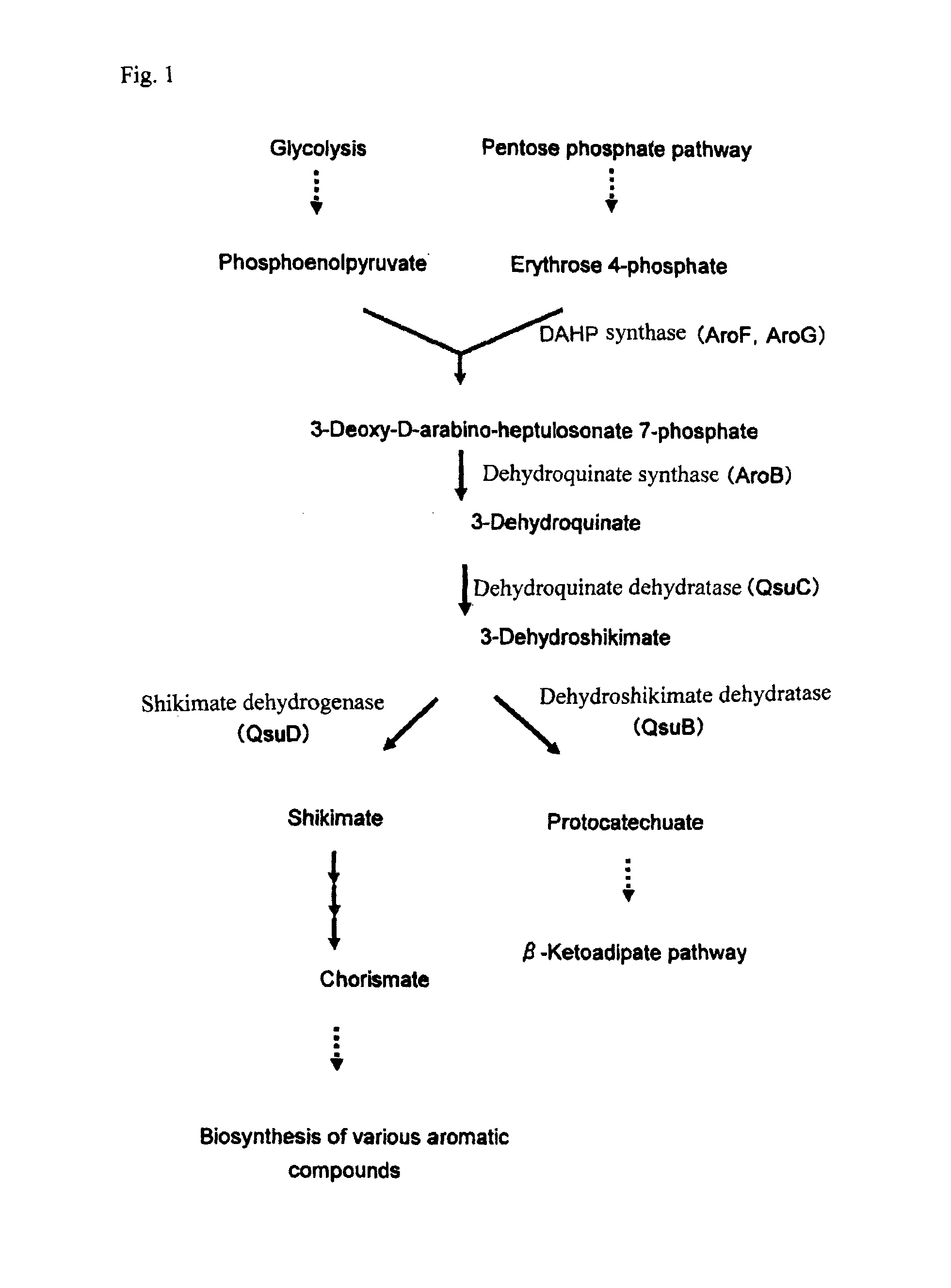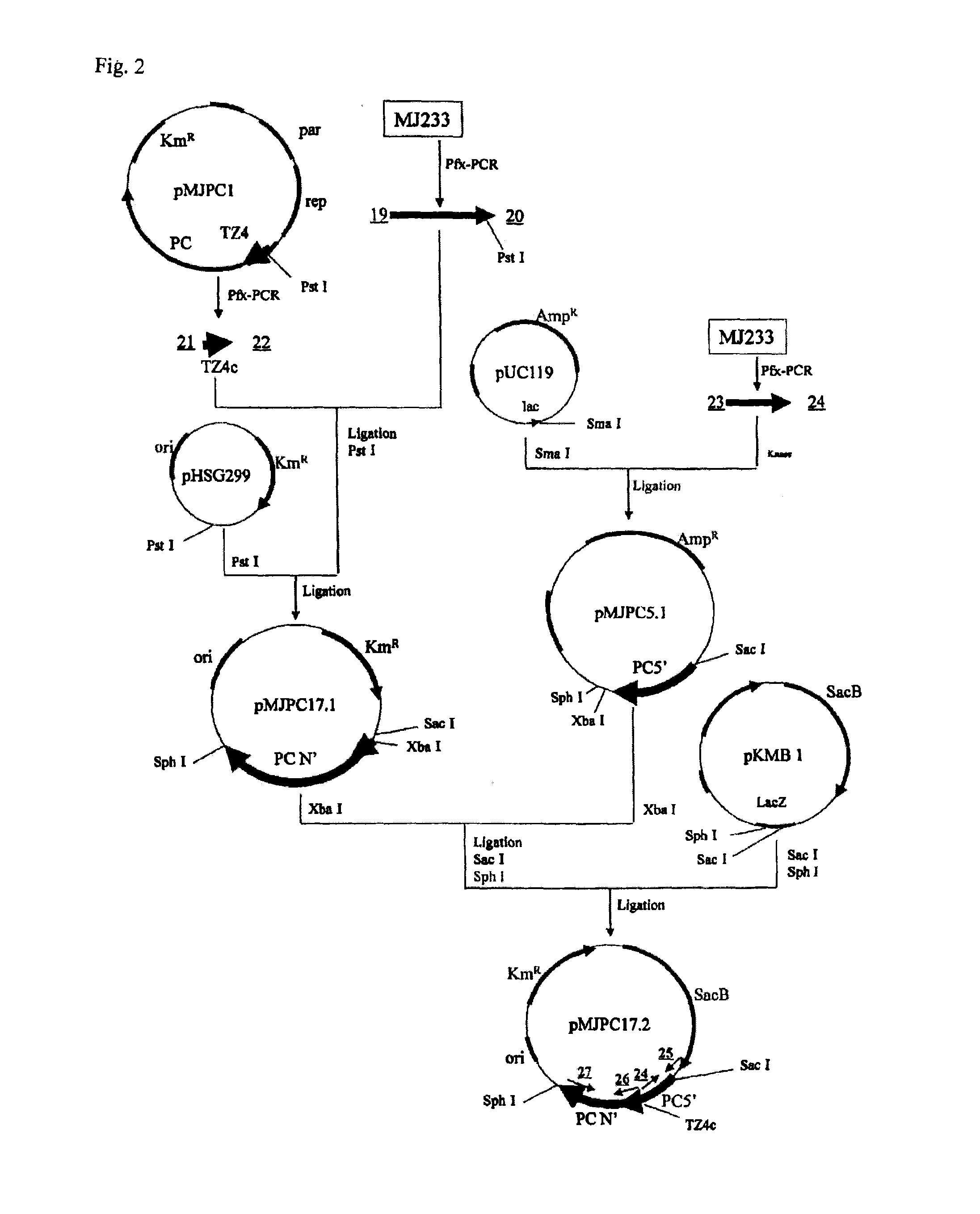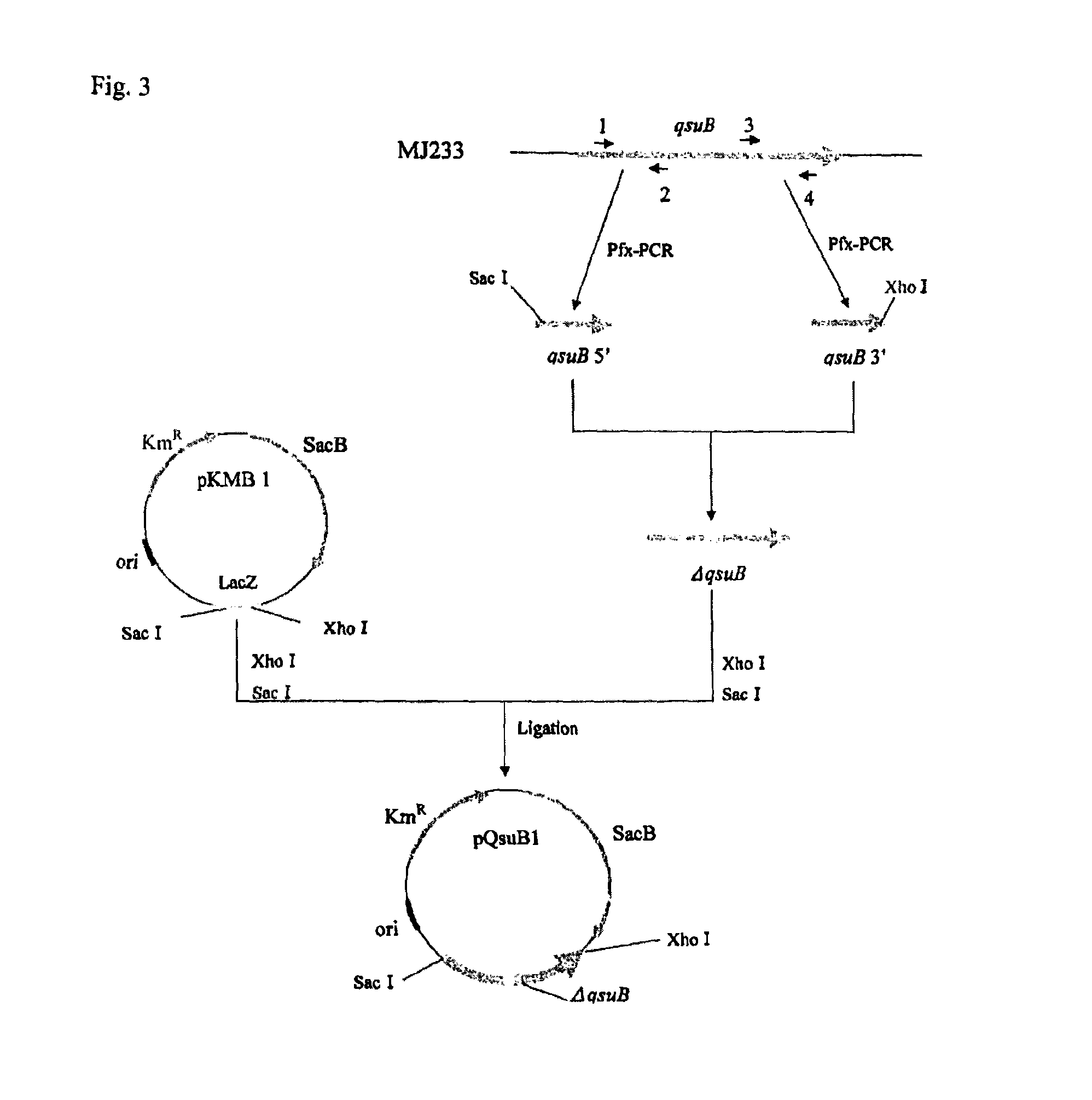Method for producing polymer, method for producing organic acid, and organic acid-producing microorganism
a technology of organic acid and polymer, which is applied in the direction of lyase, transferase, bulk chemical production, etc., to achieve the effects of reducing the production of aromatic carboxylic acids which cause coloration of polymers, less coloration, and simplifying the purification step of organic acids
- Summary
- Abstract
- Description
- Claims
- Application Information
AI Technical Summary
Benefits of technology
Problems solved by technology
Method used
Image
Examples
example 1
Preparation of Brevibacterium flavum MJ233 / ΔQsuB / PC-4 / ΔLDH] (Preparation of QsuB-Disrupted Strain)
(A) Extraction of Genomic DNA from MJ233 Strain
[0272]In 10 mL of a seed culture medium [2 g of urea, 7 g of (NH4)2SO4, 0.5 g of KH2PO4, 0.5 g of K2HPO4, 0.5 g of MgSO4.7H2O, 6 mg of FeSO4.7H2O, 6 mg of MnSO4.4-5H2O, 200 μg of biotin, 100 μg of thiamine, 1 g of yeast extract, 1 g of casamino acid and 20 g of glucose; dissolved in 1 L of distilled water], the Brevibacterium flavum MJ-233 strain was cultured until the late stage of logarithmic growth phase, and the resulting bacterial cells were collected by centrifugation (10,000 g, 5 minutes). The thus obtained bacterial cells were suspended in 0.15 mL of a 10 mM NaCl / 20 mM Tris buffer (pH 8.0) / 1 mM EDTA.2Na solution containing lysozyme at a concentration of 10 mg / mL. Then, proteinase K was added to the thus obtained suspension to a final concentration of 100 μg / mL and the resultant was incubated at 37° C. for 1 hour. Thereafter, sodium ...
reference example 1
Preparation of Brevibacterium flavum MJ233 / PC-4 / ΔLDH Strain
(Preparation of Pyruvate Carboxylase (PC)-Enhanced Strain)
(A) Extraction of Genomic DNA from Brevibacterium flavum MJ233 Strain
[0276]In 10 mL of A medium [2 g of urea, 7 g of (NH4)2SO4, 0.5 g of KH2PO4, 0.5 g of K2HPO4, 0.5 g of MgSO4.7H2O, 6 mg of FeSO4.7H2O, 6 mg of MnSO4.4-5H2O, 200 μg of biotin, 100 μg of thiamine, 1 g of yeast extract, 1 g of casamino acid and 20 g of glucose; dissolved in 1 L of distilled water], Brevibacterium flavum MJ-233 strain was cultured until the late stage of logarithmic growth phase, and the resulting bacterial cells were collected by centrifugation (10,000 g, 5 minutes). The thus obtained bacterial cells were suspended in 0.15 mL of a 10 mM NaCl / 20 mM Tris buffer (pH 8.0) / 1 mM EDTA.2Na solution containing lysozyme at a concentration of 10 mg / mL. Then, proteinase K was added to the thus obtained suspension to a final concentration of 100 μg / mL and the resultant was incubated at 37° C. for 1 h...
example 2
Production of Succinic Acid by QsuB-disrupted Strain
[0287]A medium [4 g of urea, 14 g of (NH4)2SO4, 0.5 g of KH2PO4, 0.5 g of K2HPO4, 0.5 g of MgSO4.7H2O, 20 mg of FeSO4.7H2O, 20 mg of MnSO4.H2O, 200 μg of D-biotin, 200 μg of thiamine hydrochloride, 1 g of yeast extract and 1 g of casamino acid; dissolved in 1 L of distilled water] in an amount of 100 mL was placed in a 500-mL Erlenmeyer flask and heat-sterilized at 120° C. for 20 minutes. The medium was then cooled to room temperature and 8 mL of 50% aqueous glucose solution which had been sterilized in advance and 50 μL of filter-sterilized 5% aqueous kanamycin solution were added thereto. The QsuB-disrupted strain (Brevibacterium flavum MJ233 / ΔQsuB / PC-4 / ΔLDH) prepared in Example 1 was inoculated to the resulting medium to an absorbance (OD660) of 1.0 and cultured at 30° C.
[0288]At 12 hours after the start of the culture, 3.16 g of ammonium bicarbonate was added and allowed to react with the cells with the mouth of the Erlenmeyer ...
PUM
| Property | Measurement | Unit |
|---|---|---|
| temperature | aaaaa | aaaaa |
| temperature | aaaaa | aaaaa |
| temperature | aaaaa | aaaaa |
Abstract
Description
Claims
Application Information
 Login to View More
Login to View More - R&D
- Intellectual Property
- Life Sciences
- Materials
- Tech Scout
- Unparalleled Data Quality
- Higher Quality Content
- 60% Fewer Hallucinations
Browse by: Latest US Patents, China's latest patents, Technical Efficacy Thesaurus, Application Domain, Technology Topic, Popular Technical Reports.
© 2025 PatSnap. All rights reserved.Legal|Privacy policy|Modern Slavery Act Transparency Statement|Sitemap|About US| Contact US: help@patsnap.com



